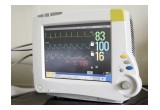Telemetry Simulation in the Classroom
Real time simulation aides in helping to train the cardiac monitor tech.
The National Telemetry Association recently purchased the LifePak Automated External Defibrillator monitor along with the Cardiac Arrhythmia Generator to help train hospital Telemetry Technician's. Nancy Kimmel, FNP-BC states that, "Using the Physio-Control AED to train students is a great visual aide. Whether online or in class, students can get a real feel for the patient's heart rhythm and see first hand how a normal rhythm can deteriorate quickly."
The Physio Control LifePak 9 defibrillator/monitor was designed to meet the needs of clinical, biomedical engineering, and purchasing professionals throughout the world. The LifePak Defibrillator has an EASY 1-2-3 operation with built-in noninvasive user-friendly display, plus its compact, portable, space-saving design, revolutionized in-hospital defibrillation.
Innovative features include high and low energy select displays, annotating recorder that prints out time, date, leads, gain, and CODE SUMMARY critical event record, which recaps critical events from the moment of "power on ".
One of the most important steps in curriculum development is the introduction of simulation- based medical teaching and learning. Simulation is a generic term that refers to an artificial representation of a real world process to achieve educational goals through experiential learning. Simulation based medical education is defined as any educational activity that utilizes simulation aides to replicate clinical scenarios. Telemetry or Monitor Technicians are responsible for recognizing patterns of rhythms and dangerous changes. The importance of their job cannot be under estimated. The must be able to recognize dangerous heart Electrocardiogram wave patterns and react immediately. With the new medical rhythm simulators the student is now able to practice their speed and accuracy in rhythm recognition.
Although medical simulation is relatively new, simulation has been used for a long time in the medical profession. Telemetry cardiac monitor simulation allows the acquisition of clinical skills through deliberate practice rather than an apprentice style of learning. Simulation tools serve as an alternative to real patients. A telemetry trainee can make mistakes and learn from them without the fear of harming the patient. There are different types and classification of simulators and their cost vary according to the degree of their resemblance to the reality. Visual practical based learning is expensive. However, it is cost-effective if utilized properly. Medical simulation has been found to enhance clinical competence at the undergraduate and postgraduate levels. It has also been found to have many advantages that can improve patient safety and reduce health care costs through the improvement of the medical provider's competencies. It is the goal of the National Telemetry Association to provide the best education possible to hospitals cardiac technicians to help them save lives.
Related Links
Telemetry Certification
Telemetry Technician Resources
Related Images

Telemetry Simulation in the Classroom
Real time simulation aides in helping to train the cardiac monitor tech.

Telemetry Technicians understand the way the heart works
visual aides are indispensable to the telemetry tech

The National Telemetry Association trains Technicians all over the world
Visual simulation aides help cardiac monitor techs to understand trending of heart rhythms.

Training simulation tools for telemetry
This is one of the training monitors that students will be working with in the next few weeks.
Press Release Service by Newswire.com
Original Source: National Telemetry Association Purchases Advanced Classroom Training Equipment


